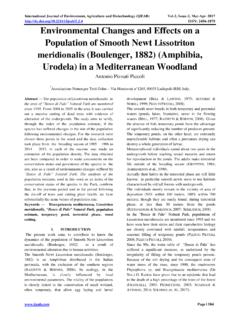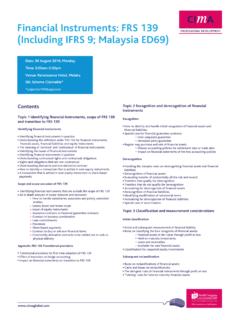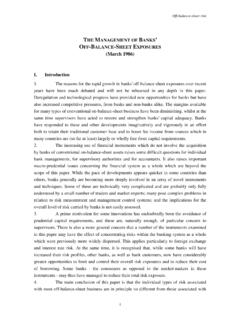Transcription of BASICS OF CAPITAL MARKET INVESTING - …
1 1 BASICS OF CAPITAL MARKET INVESTING Table of Contents What are CAPITAL Markets? Understanding Debt Investments Factors affecting Exchange Rates Equity Investments Mutual Funds Investments 2 BASICS OF CAPITAL MARKET INVESTING This booklet is intended for those who are not familiar with the intricacies of INVESTING in the CAPITAL markets. We hope that after reading this, some of the hi-finance terminology will become somewhat demystified. Our emphasis will be in pointing out the varying levels of risks that are involved and how an investor should weigh his or her options to achieve a realistic rate of return. The markets can move both ways, up and down, but an average investor is more sensitive to the risk of loss of CAPITAL and we therefore give more attention to this fact.
2 WHAT ARE CAPITAL MARKETS? In order to understand this term, it is necessary to define the broad categories of investments: Forms of investment Investments can be in various forms, some of these are: real estate, business enterprises, precious metals and stones, valuable works of art, financial investments etc. Some forms of investment may have a non-financial reward too, such as aesthetic or emotional pleasure from works of art, jewellery, house property etc., but in most cases we strive to at least retain the purchasing power of our savings ( beat inflation) and preferably come out ahead. Financial Investments As opposed to physical assets, financial investments are generally a right or an entitlement to receive money (or streams of money).
3 The Financial investments themselves are in two broad categories direct investments, that we hand over to an obligor (the party that uses our money) and get back our entitlement (dividends, interest, principal etc.) from the obligor (Examples are bank deposits and investments in the National Savings Schemes) and MARKET -based investments that we (normally but not always) take over from some other investor; and when we want to encash our investment, we find someone in the MARKET to take over our investment from us. (Examples are shares of companies, bonds issued by companies called TFCs in our MARKET ) or tradable bonds issued by the government, etc. Financial investments are normally represented by certificates, generally referred to as securities.
4 However, there is a trend to convert securities into a paperless (electronic) form, which is kept track of, by a custodian such as the Central Depository Company (CDC). The essential attribute of a MARKET -based tradable investment is that one can sell the investment and get cash for it. CAPITAL Markets This is the MARKET place where financial investments (normally of a long-term nature) can be acquired or disposed off. The term is used in the plural to signify separate MARKET segments for various types of financial investments. The stock exchange (also referred to as the stock MARKET ) is where shares and bonds issued by business entities (companies) are traded. There is sub-category called the Money MARKET , which is normally the MARKET for acquiring or disposing off very short-term financial investments but will include inter-bank placement of very short-term deposits and dealings in currencies too.
5 Equity Vs Debt When we invest money with a business entity, it can either be in the capacity of becoming a partner in the business or we can lend money to the business entity for a defined time period. Equity In the first capacity, we participate in the ownership of the business and have an equitable right (legally enforceable right) in the business, to the extent of our share in it. Thus we become an equity or share holder both terms are synonymous in the investment parlance. As an equity investor, we are entitled to 3 distribution of profits and in the event the business is liquidated at some stage, we are entitled to our share of the net assets left over. Debt In this case we have a debt that we have to recover from the business in accordance with an agreed repayment schedule and we are entitled to compensation for the use of our money (interest, by whatever name called).
6 The money we invest with government and banks is also in the category of debt. From the point of view of the borrowing entity, we are a creditor and we rank senior to equity in the event of liquidation creditors will be paid off first and whatever is left over after that will go to the equity holders (owners). UNDERSTANDING DEBT INVESTMENTS As has been explained earlier, we pay out certain monies now and expect to get back some interest and the principal later. The factors that impact this type of investment are two types of risk: Risk to Principal First and foremost, the risk to the principal is affected by the reliability of the borrower. The government is considered a safe borrower we do not expect it to default.
7 We normally also place a fair amount of reliance on banks and expect that they have a low likelihood of default. In the case of other businesses, we place reliance on the specific business entity depending on who is running the business and what type of business it is. This is also referred to as credit risk. Inflation Risk The second type of risk is the underlying inflation rate we clearly want an interest rate that will not fall short of the inflation rate during the period of the investment. Otherwise we will not retain the purchasing power of our principal. For example, if we invest Rs. 100,000 for a year at an interest rate of 4% and during this period the inflation rate turns out at 5%, we will need Rs.
8 105,000 to purchase something that cost Rs. 100,000 a year ago but we will only have Rs. 104,000 from our investment , we would have suffered a loss in our purchasing power by the end of the year. This is also referred to as interest rate risk . Valuing Debt Securities In relation to the CAPITAL markets, our concern is with understanding the risk and reward of a debt security and as to how the MARKET puts a value to it. This becomes important for us when we want to buy a security from the MARKET or when we wish to sell it. We must remember that the MARKET functions on the basis of demand and supply. There will be demand for debt securities in general, based on the investible surplus available with investors and for a debt security in particular based on its riskiness and the rate of return in relation to the expected inflation rate.
9 The supply of debt securities comes from borrowers needing the funds. The impact of riskiness and inflation are discussed in the following paragraphs. Interest Rate Vs Inflation Rate The interest rate that a borrower has to pay will normally have to be in excess of the expected inflation rate. Please note that whereas the interest rate has to be agreed at the time of borrowing, the inflation rate for the borrowing period can only be guessed. This in itself generates a new risk; the longer the period of borrowing, the riskier it is to guess the inflation rate. The Benchmark Rate As was stated earlier, the government is considered a safe borrower and it is the interest rate the government has to pay that is used as the benchmark for other borrowers.
10 The government is considered to 4 have zero risk (of default) and should be able to attract debt at an interest rate slightly over the expected inflation rate. As has also been stated earlier, the reliability of the inflation estimate diminishes with the length of life of the debt (normally referred to as tenure or tenor of the security). That is, it is more difficult and more risky to predict the direction of economic forces over longer time frames. We therefore find that Treasury Bills (normally up to one-year government bonds) carry the lowest effective interest rate and longer tenor government bonds have to offer a higher rate of return. All the commercial borrowers (normally termed as corporate sector) have to offer rates higher than the benchmark for that tenor.



